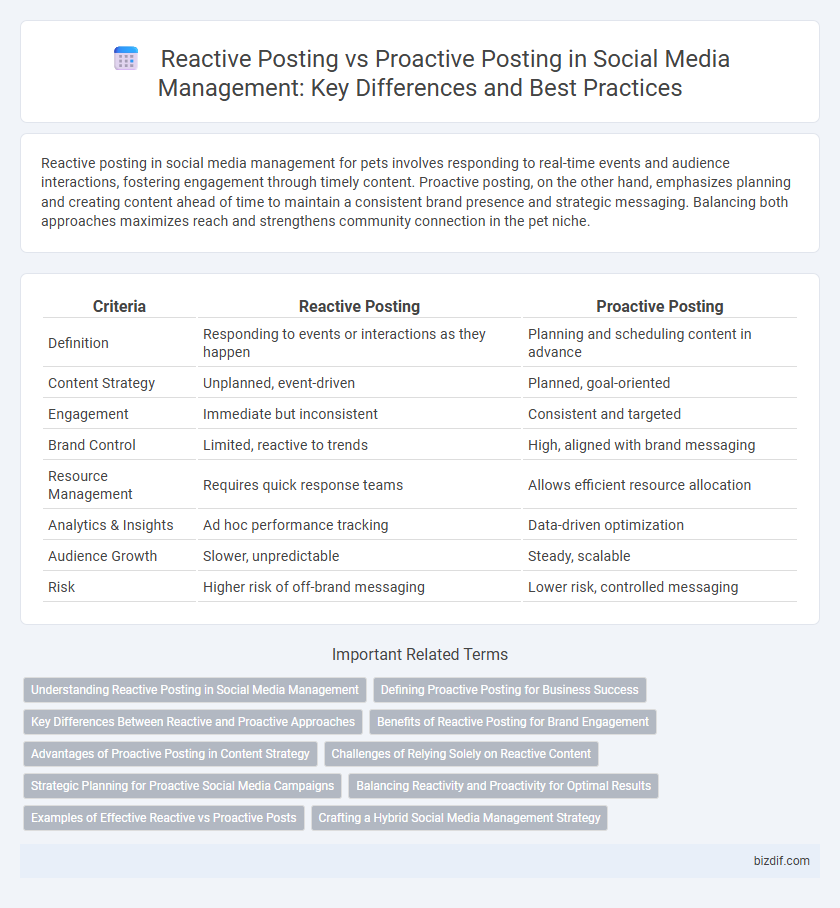Reactive posting in social media management for pets involves responding to real-time events and audience interactions, fostering engagement through timely content. Proactive posting, on the other hand, emphasizes planning and creating content ahead of time to maintain a consistent brand presence and strategic messaging. Balancing both approaches maximizes reach and strengthens community connection in the pet niche.
Table of Comparison
| Criteria | Reactive Posting | Proactive Posting |
|---|---|---|
| Definition | Responding to events or interactions as they happen | Planning and scheduling content in advance |
| Content Strategy | Unplanned, event-driven | Planned, goal-oriented |
| Engagement | Immediate but inconsistent | Consistent and targeted |
| Brand Control | Limited, reactive to trends | High, aligned with brand messaging |
| Resource Management | Requires quick response teams | Allows efficient resource allocation |
| Analytics & Insights | Ad hoc performance tracking | Data-driven optimization |
| Audience Growth | Slower, unpredictable | Steady, scalable |
| Risk | Higher risk of off-brand messaging | Lower risk, controlled messaging |
Understanding Reactive Posting in Social Media Management
Reactive posting in social media management involves responding promptly to current events, trending topics, or audience interactions to maintain engagement and relevance. This strategy allows brands to capitalize on real-time opportunities, fostering a dynamic connection with their audience and enhancing brand visibility. Organizations leveraging reactive posting often see increased user interaction and timely participation in conversations within their industry.
Defining Proactive Posting for Business Success
Proactive posting involves strategically planning and scheduling content to align with business goals, customer interests, and key market trends, ensuring consistent brand presence and engagement. By anticipating audience needs and seasonal opportunities, businesses can foster stronger relationships and drive long-term growth. This approach maximizes reach and optimizes resource allocation compared to reactive posting, which responds only to immediate events or feedback.
Key Differences Between Reactive and Proactive Approaches
Reactive posting centers on responding to trends, audience interactions, and current events as they happen, prioritizing immediate engagement and relevance. Proactive posting involves strategic planning, scheduling content ahead of time based on audience insights and marketing goals, ensuring consistent messaging and brand alignment. The key differences lie in timing, control over content, and the balance between spontaneity and foresight in social media management.
Benefits of Reactive Posting for Brand Engagement
Reactive posting allows brands to capitalize on trending topics and real-time conversations, increasing visibility and relevance among target audiences. Engaging promptly with current events or customer feedback fosters authentic interactions, boosting brand loyalty and trust. This approach enhances responsiveness, which can significantly improve overall engagement rates and customer satisfaction on social media platforms.
Advantages of Proactive Posting in Content Strategy
Proactive posting in social media management enables brands to consistently deliver tailored content that aligns with audience interests and industry trends, fostering stronger engagement and brand loyalty. Scheduling posts in advance allows for thorough content planning, ensuring quality and coherence across platforms while optimizing peak posting times for maximum reach. This strategic approach reduces the risk of last-minute content gaps and leverages analytics to refine messaging, resulting in improved overall campaign performance.
Challenges of Relying Solely on Reactive Content
Relying solely on reactive posting in social media management often leads to missed opportunities for strategic audience engagement and brand consistency. This approach can result in delayed responses, making it difficult to shape brand narratives proactively or capitalize on trending topics. Brands that depend exclusively on reactive content struggle with maintaining relevance and fostering long-term follower loyalty.
Strategic Planning for Proactive Social Media Campaigns
Proactive posting in social media management involves strategic planning based on data-driven insights, audience behavior, and trending topics to schedule content that maximizes engagement and brand visibility. This approach enables brands to control their messaging, align posts with marketing calendars, and anticipate audience needs, resulting in higher ROI and sustained growth. Reactive posting, while responsive to real-time events, lacks the foresight needed for cohesive campaigns and long-term brand positioning.
Balancing Reactivity and Proactivity for Optimal Results
Balancing reactivity and proactivity in social media management enhances engagement and brand presence by combining timely responses with strategic content planning. Reactive posting capitalizes on trending topics and immediate audience interactions, while proactive posting builds long-term narratives and consistent messaging. Integrating both approaches maximizes reach, fosters community loyalty, and drives sustained growth across platforms.
Examples of Effective Reactive vs Proactive Posts
Reactive posting on social media often includes timely responses to trending topics, such as brands joining viral challenges or addressing current events to engage audiences immediately. Proactive posts involve planned content like scheduled product launches, educational series, or seasonal campaigns designed to build long-term brand awareness and audience loyalty. For example, a reactive post might be a quick response to a breaking news story relevant to the brand, whereas a proactive post could be a monthly content calendar with themed posts and strategic calls-to-action.
Crafting a Hybrid Social Media Management Strategy
Crafting a hybrid social media management strategy involves balancing reactive posting, which addresses real-time trends and audience interactions, with proactive posting that ensures consistent brand messaging and planned content delivery. Leveraging analytics tools helps identify optimal posting times and trending topics to maximize engagement. Integrating both approaches enables marketers to maintain relevance while driving strategic goals and audience growth.
reactive posting vs proactive posting Infographic

 bizdif.com
bizdif.com